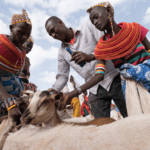From Farm to Phone to Table: A Case Study Series Explores the Impact of Digital Tools on Agriculture
Over the past 10 years, and particularly over the past five, the use of mobile phones and internet-enabled, digital tools in farming activities has skyrocketed. Today, the smartphone or tablet is no longer seen just in the developed world; at least one mobile phone now sits in the pockets or hands of over 60 percent of the population in the developing world. Coupled with the increased spread of 3G and 4G connectivity, and the growing presence of mobile money products, low-cost sensors, geospatial visualization and machine learning, what has emerged is a broad set of digitally based applications that have driven greater financial inclusion, more precision agriculture, better data collection and analytics, and more effective information dissemination. Agricultural organizations are increasingly embracing these tools to better provide for the welfare of the communities they serve.
The U.S. Agency for International Development, through the U.S. Global Development Lab and the Bureau for Food Security, is working to demonstrate that digital tools and approaches can improve cost-effectiveness and better development outcomes in food security and nutrition programs. As part of this effort, USAID is launching a case study series to highlight different approaches to digital tool adoption and how these tools are impacting organizational culture, operations and programming.
The series profiles different organizations, from social enterprises to non-governmental organizations and traditional private businesses across a number of regions, from sub-Saharan Africa to Latin America to South and Southeast Asia. Greater attention is being given to Feed the Future (the U.S. government’s global hunger and food security initiative) countries and the newly released target countries under the Global Food Security Strategy. Most organizations and projects being showcased have received some form of USAID assistance.
Using Digital Tools to Enhance Food Security, Nutrition Programs
Each case study examines the specific digital landscape in which the activity is operating and how this affects the choice of tools and options for dissemination. No two digital integration experiences are the same, and the case studies reveal the adoption of a diverse set of digital tools ranging in complexity, customization and focus. In Senegal, for instance, Naatal Mbay is using basic tools like Microsoft Excel and Dropbox to demonstrate to producer-serving organizations the power of data for more effective programming. In contrast, One Acre Fund built a custom tablet app to enroll clients faster and with fewer mistakes. The new app replaces a paper-based process for field officers and prompts them to nudge clients about new and tailored products available for purchase.

Monitoring and Evaluation enumerator Isaac Masebo interviews smallholder farmer Diana Nalianya about which crops she grows in her field and why as part of a survey to help One Acre Fund learn more about the farmers they serve. Isaac uses a tablet to record Diana’s answers.
A key focus of the series is on understanding the collective impact of digital tools while trying to assess the status quo without them. Among other benefits, they are expected to accelerate the achievement and deepen the impact of development objectives, leading for example to greater productivity or more inclusive financial outcomes. Capturing this impact can be elusive given that few organizations have begun to measure the additional impact that digital tools can produce. That’s why impact is understood in a number of different ways across the case studies. Where quantitative data is available, it is highlighted. For example, in Senegal, the predecessor project to Naatal Mbay, Projet Croissance Economique, attributed a 25 percent increase in maize yields for 25,000 farmers to its digital data management systems.
Elsewhere, impact is understood by capturing the changed image users of the digital tools have of themselves and of their work. Take for instance a female field officer for One Acre Fund who explained how using a tablet to enroll clients made her feel “more professional,” enabling her to “approach a farmer with confidence” that she will get the attention she deserves. Or consider a male farmer in Senegal who explained: “I used to think that the computers were something that only the people in offices used. They were not something that farmers could use. But these tools are important [for us] because they help the farmers understand the size of their plots. And with GPS, farmers know precisely how much seed and inputs to apply and they can better understand performance. Before we didn’t have context for [understanding] our performance.”
The case studies conclude with reflections from users about what they have learned through the digital integration process. These are framed through the lens of the Principles for Digital Development, a set of best practices developed and endorsed by donors and the development community, across more than 100 organizations, to guide and inform technology-enabled development programs. Few organizations are successful in operationalizing all the principles at this stage, but most are on a path of continual learning and growth.
So far, four case studies have been completed and two more are in the works. But we’re on the lookout for up to six more. The number of agricultural projects and organizations that are embracing digital technologies continues to grow. For those that are seeing success from your efforts, we would like to showcase your work. If you’re interested, or if you know of a project that fits the bill – either within the Feed the Future Initiative or across the agricultural sector more broadly – please reach out to us here.
Cristina Manfre is senior associate with Cultural Practice, LLC. Christopher Burns is the senior coordinator, digital development for Feed the Future at USAID.
Photos by Hailey Tucker, One Acre Fund
- Categories
- Agriculture, Technology



